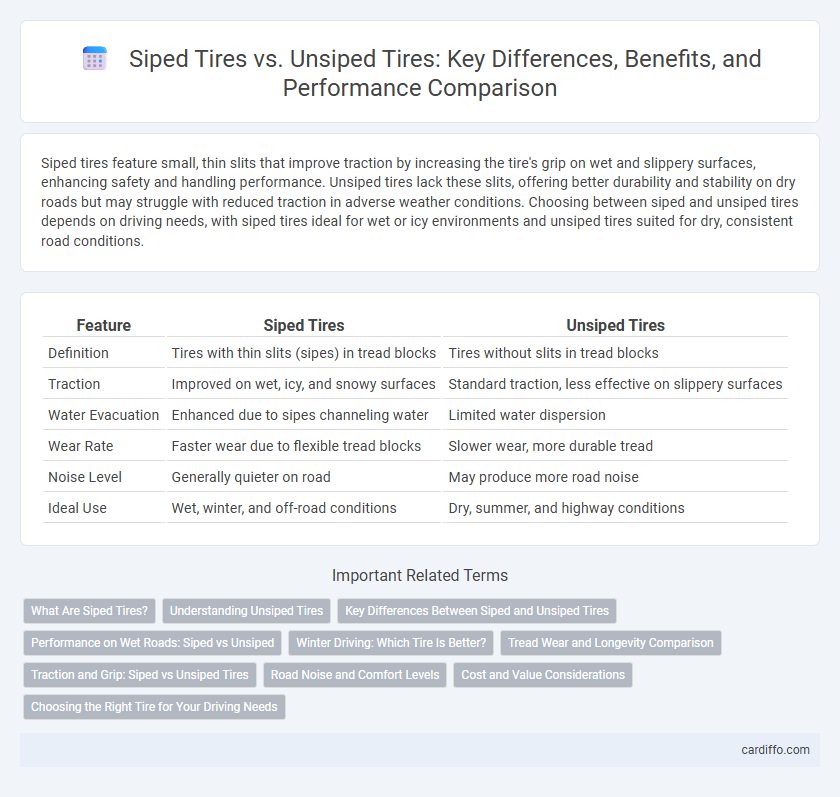Siped tires feature small, thin slits that improve traction by increasing the tire's grip on wet and slippery surfaces, enhancing safety and handling performance. Unsiped tires lack these slits, offering better durability and stability on dry roads but may struggle with reduced traction in adverse weather conditions. Choosing between siped and unsiped tires depends on driving needs, with siped tires ideal for wet or icy environments and unsiped tires suited for dry, consistent road conditions.
Table of Comparison
| Feature | Siped Tires | Unsiped Tires |
|---|---|---|
| Definition | Tires with thin slits (sipes) in tread blocks | Tires without slits in tread blocks |
| Traction | Improved on wet, icy, and snowy surfaces | Standard traction, less effective on slippery surfaces |
| Water Evacuation | Enhanced due to sipes channeling water | Limited water dispersion |
| Wear Rate | Faster wear due to flexible tread blocks | Slower wear, more durable tread |
| Noise Level | Generally quieter on road | May produce more road noise |
| Ideal Use | Wet, winter, and off-road conditions | Dry, summer, and highway conditions |
What Are Siped Tires?
Siped tires feature thin slits cut across the tread blocks that enhance traction by creating additional biting edges, especially on wet, icy, or snowy surfaces. These small grooves improve water evacuation and increase grip, reducing the risk of hydroplaning and enhancing overall vehicle control. In contrast to unsiped tires, siped tires offer superior performance under slippery conditions by maintaining better contact with the road.
Understanding Unsiped Tires
Unsiped tires lack the thin slits, or sipes, that enhance traction on wet and icy surfaces by improving grip and water evacuation. They generally provide better performance on dry roads due to increased rubber contact with the surface, which translates to improved handling and tread life. However, unsiped tires may experience reduced traction in slippery conditions compared to siped alternatives.
Key Differences Between Siped and Unsiped Tires
Siped tires feature small, narrow slits in the tread that enhance traction on wet, icy, and snowy surfaces by increasing grip and water evacuation. Unsiped tires lack these slits, offering better tread durability and performance on dry roads but reduced traction in adverse weather conditions. The key difference lies in siping's impact on safety and handling, with siped tires optimized for wet-weather grip and unsiped tires designed for longer tread life and dry performance.
Performance on Wet Roads: Siped vs Unsiped
Siped tires feature small slits that enhance traction by channeling water away from the tread, significantly reducing hydroplaning risk on wet roads. Unsiped tires lack these grooves, resulting in less efficient water dispersion and decreased grip under wet conditions. This design difference makes siped tires superior for maintaining control and safety during rain or wet driving environments.
Winter Driving: Which Tire Is Better?
Siped tires provide superior traction on winter roads by featuring thin slits that create additional biting edges for enhanced grip on ice and packed snow. Unsiped tires lack these slits, resulting in reduced traction and longer stopping distances in cold, slippery conditions. For optimal safety and control during winter driving, siped tires are the preferable choice.
Tread Wear and Longevity Comparison
Siped tires feature small slits in the tread blocks that enhance traction and distribute wear more evenly, resulting in improved tread lifespan compared to unsiped tires. Unsiped tires typically experience faster tread wear due to less effective heat dissipation and traction control, which can lead to premature replacement. Studies indicate that siped tires can increase tread longevity by up to 20% under similar driving conditions.
Traction and Grip: Siped vs Unsiped Tires
Siped tires feature thin slits in the tread that enhance traction by increasing the tire's ability to grip wet and slippery surfaces, significantly improving braking and handling performance. Unsiped tires lack these slits, which can reduce grip on icy or wet roads, but often provide better durability and performance on dry pavement. Consequently, siped tires are preferred for driving in variable weather conditions where maintaining traction is critical for safety.
Road Noise and Comfort Levels
Siped tires feature thin slits in the tread that enhance traction and help reduce road noise by disrupting sound waves, resulting in a quieter ride compared to unsiped tires. Unsiped tires tend to generate more road noise due to their solid tread blocks, which can produce harsher vibrations on smooth pavement. Comfort levels are typically higher with siped tires as the additional flexibility in the tread absorbs shocks better, contributing to a smoother driving experience.
Cost and Value Considerations
Siped tires generally cost more upfront due to the intricate manufacturing process that enhances traction by increasing the number of biting edges on the tread. Despite the higher initial investment, siped tires often deliver better grip on wet and icy surfaces, extending tire life and improving safety, which can justify the added expense over time. Unsiped tires, while cheaper initially, may require more frequent replacements and offer reduced performance in adverse conditions, potentially increasing long-term costs.
Choosing the Right Tire for Your Driving Needs
Siped tires offer enhanced traction and improved wet and icy road performance by featuring thin slits that increase flexibility and grip. Unsiped tires, with a more solid tread design, provide better durability and handling on dry surfaces, making them ideal for everyday driving in mild conditions. Selecting between siped and unsiped tires depends on your typical driving environment, prioritizing safety in wet or snowy conditions versus longevity and performance on dry roads.
Siped tires vs Unsiped tires Infographic

 cardiffo.com
cardiffo.com